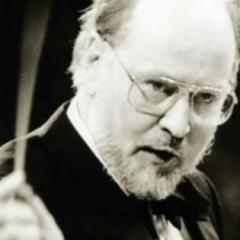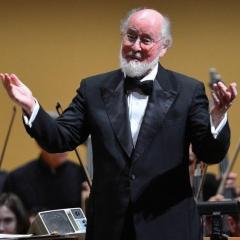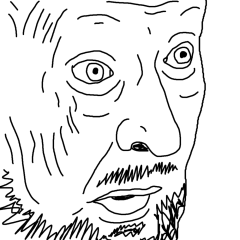-
Posts
1,077 -
Joined
-
Last visited
-
Days Won
13
Ludwig last won the day on October 9 2022
Ludwig had the most liked content!
Contact Methods
-
Website URL
www.filmmusicnotes.com
Profile
-
Title (custom text underneath your username)
Music Theorist / Musicologist
Recent Profile Visitors
18,567 profile views
-
 artus_grayboot reacted to a post in a topic:
GALAXY'S EDGE - New John Williams composition (2018)
artus_grayboot reacted to a post in a topic:
GALAXY'S EDGE - New John Williams composition (2018)
-
 Jurassic Shark reacted to a post in a topic:
Film Music Notes blog post - Rhythm in John Williams' Theme Openings
Jurassic Shark reacted to a post in a topic:
Film Music Notes blog post - Rhythm in John Williams' Theme Openings
-
 Ludwig reacted to a post in a topic:
NEW! THE SUGARLAND EXPRESS - World Premiere Original Motion Picture Soundtrack - La-La Land Records
Ludwig reacted to a post in a topic:
NEW! THE SUGARLAND EXPRESS - World Premiere Original Motion Picture Soundtrack - La-La Land Records
-
 BrotherSound reacted to a post in a topic:
Film Music Notes blog post - Rhythm in John Williams' Theme Openings
BrotherSound reacted to a post in a topic:
Film Music Notes blog post - Rhythm in John Williams' Theme Openings
-

Film Music Notes blog post - Rhythm in John Williams' Theme Openings
Ludwig replied to Ludwig's topic in JOHN WILLIAMS
Absolutely! The use of rhythm as a fundamental part of a theme's identity is one of Williams' true gifts. I always think the Indy theme is one of the best in this respect. The main short motif that starts the theme never ends with the same rhythm twice in a row. So the ordering of the motif's rhythms gives a kind of aural roadmap of the theme, making it easy to follow. Finding that balance between sameness and difference can be pretty difficult to pull off, which is probably why he says he slaves over his themes more than anything else in a score! -
 Ludwig reacted to a post in a topic:
Film Music Notes blog post - Rhythm in John Williams' Theme Openings
Ludwig reacted to a post in a topic:
Film Music Notes blog post - Rhythm in John Williams' Theme Openings
-
 Jurassic Shark reacted to a post in a topic:
Monty Python 1969-2014
Jurassic Shark reacted to a post in a topic:
Monty Python 1969-2014
-
 karelm reacted to a post in a topic:
The Empire Strikes Back
karelm reacted to a post in a topic:
The Empire Strikes Back
-
Yes, that makes sense. It meshes well with how Across the Stars is a tragic, minor-key "shadow" of Luke's theme.
-
 Ludwig reacted to a post in a topic:
The Empire Strikes Back
Ludwig reacted to a post in a topic:
The Empire Strikes Back
-
It's definitely a full statement of the theme, it's just that it has all that dialogue overtop whereas I was looking at places where the music is the part of the sound leading the narrative since they seemed to be "bigger" moments in the story. For me, this scene has a feeling of leaving loose ends for the next movie to pick up on rather than being a plot point that initiates or resolves a major story arc. Like this is kind of in the middle of things rather than at a beginning or end, I guess is why I feel it's different even if the theme was left alone with no dialogue.
-
 karelm reacted to a post in a topic:
The Empire Strikes Back
karelm reacted to a post in a topic:
The Empire Strikes Back
-
Oh totally. I think the concept works best in the context of the OT, which is how I frame it in the original blog post. So in general I agree the prequels have too much tracking for this kind of thing to be consistent. And I agree the last statement in ROTS is of course directly referencing the original Binary Sunset since we see the sunset yet again! I suppose I see AOTC differently only because it marks probably the most significant event in Anakin's trajectory in the film. I wouldn't expect we'd all agree on what these things mean, exactly. I just brought it up because I thought it's kind of cool how the AOTC statement can be seen in a broader context of these basically dialogue-free full statements being somewhat special when viewed across many of the Star Wars films, particularly the first three. But as I say, I totally agree that the idea doesn't hold up nearly as well in the prequels.
-
 oierem reacted to a post in a topic:
The Empire Strikes Back
oierem reacted to a post in a topic:
The Empire Strikes Back
-
 Chen G. reacted to a post in a topic:
The Empire Strikes Back
Chen G. reacted to a post in a topic:
The Empire Strikes Back
-
The way Anakin's and Obi-Wan's ships fly in unison during this theme makes me think that, through the full closure of the theme, Williams may have been suggesting the closeness and stability of the relationship between the two at this point so that its unraveling during the course of the film is all the more effective musically.
-
 Ludwig reacted to a post in a topic:
The Empire Strikes Back
Ludwig reacted to a post in a topic:
The Empire Strikes Back
-
 Chen G. reacted to a post in a topic:
The Empire Strikes Back
Chen G. reacted to a post in a topic:
The Empire Strikes Back
-
Yes! And the one starting Revenge of the Sith does too, where Anakin and Obi-Wan go into battle.
-
So to answer both at once, I think the examples I point to here are ones where the music takes over as the main component of the film's sound. That's really what I mean by "foregrounded" in these cases in the blog post. The other scenes you mention certain have full statements of the theme, but I think what I was after was those moments where the dialogue falls away and the music leads the scene. I know Williams regularly talks about competing with other sounds in the film audio, so I have to imagine that moments like these would really stand out to him because the film is calling on him to be the main storyteller rather than dialogue. So yes, of course there are other moments where the Force theme is heard in full, but it's the ones that are given this special audio spotlight that I was focusing on.
-
I actually looked into uses of the Force theme in a blog post some time ago and found that this statement was among a relatively small number that were the complete theme and foregrounded in the film. When Williams used the theme in this way in the first six films, they tended to be mark major points in the plot of the Empire/Trade Federation: A New Hope - Binary sunset - suggesting Luke's destiny to become a Jedi - Throne room - victory over the Empire Empire Strikes Back - has none, interestingly, probably because the plot focuses not on defeating the Empire but escaping from it (and also introduces the love between Han and Leia, and Yoda as a new character) Return of the Jedi - Luke lights Vader's funeral pyre The Phantom Menace - Boy Anakin destroys the Trade Federation ship Attack of the Clones - Anakin leaves Padme to search for his mother and ends up slaughtering the sand people - beginning of his descent into evil Revenge of the Sith - statements focus on Obi-Wan or the partnership of Anakin and Obi-Wan, which is central to the plot: - Obi-Wan and Anakin enter huge battle with Federation - Obi-Wan and Anakin manage to crash land their ship on Coruscant - Obi-Wan leaves for Utupau to battle Grievous - The last statement focuses on Luke - his adoptive parents hold him as a baby as they watch a binary sunset, paralleling that of A New Hope
-
 Ludwig reacted to a post in a topic:
NEW! THE SUGARLAND EXPRESS - World Premiere Original Motion Picture Soundtrack - La-La Land Records
Ludwig reacted to a post in a topic:
NEW! THE SUGARLAND EXPRESS - World Premiere Original Motion Picture Soundtrack - La-La Land Records
-
 artus_grayboot reacted to a post in a topic:
Analysis - Across the Stars
artus_grayboot reacted to a post in a topic:
Analysis - Across the Stars
-
 Ludwig reacted to a post in a topic:
John Williams In Tokyo - New live concert album coming May 3rd, 2024 from Deutsche Grammophon
Ludwig reacted to a post in a topic:
John Williams In Tokyo - New live concert album coming May 3rd, 2024 from Deutsche Grammophon
-
 Ludwig reacted to a post in a topic:
NEW book by Frank Lehman - The Skywalker Symphonies: Musical Storytelling in Star Wars
Ludwig reacted to a post in a topic:
NEW book by Frank Lehman - The Skywalker Symphonies: Musical Storytelling in Star Wars
-
 Ludwig reacted to a post in a topic:
The John Williams Piano Collection
Ludwig reacted to a post in a topic:
The John Williams Piano Collection
-
 Ludwig reacted to a post in a topic:
Mark Graham just picked up a John Williams sketch and is "in a rush"! Any ideas?
Ludwig reacted to a post in a topic:
Mark Graham just picked up a John Williams sketch and is "in a rush"! Any ideas?
-

John Williams on Variety Cover (article & video)
Ludwig replied to JNHFan2000's topic in JOHN WILLIAMS
5 things I loved in this article: Williams confirms the Jaws theme is three different notes (not two!). He keeps a poster of The Adventures of Robin Hood in his office doorway. Like many others, the author feels that film music succeeding in the concert hall is largely because of Williams. Mangold got emotional at the final Dial of Destiny session because he felt Williams doing his job confirmed a kind of idealism of working in film. Williams will have some free composing time this year that he may want to fill "if there’s an opportunity there that I think I can fill and enjoy doing with people I will enjoy." -
 Ludwig reacted to a post in a topic:
John Williams on Variety Cover (article & video)
Ludwig reacted to a post in a topic:
John Williams on Variety Cover (article & video)
-
Late to the party, but thought I would add that there seems to be a connection between Williams' use of fugues in film and that of William Walton. The 1942 film, The First of the Few, is about the conception and construction of Britain's Spitfire fighter plane for World War II. In the scene where the Spitfire is finally being assembled, Walton writes a fugue. Now as @Falstaft rightly pointed out, a fugue is basically a texture that is built up one voice (melody line) at a time. The first voice announces the line that is the whole basis of the fugue, and is always called the "subject". Then another line enters with the same melody, as a rule transposed (usually up) by 5th to become the "answer", while the first voice continues with other material. Then another voice enters with the same melody, and so on... Anyway, I lay this out again because I think this idea of gradually building up a texture from a single line nicely captures something in the process of making preparations. Things start off simply but become increasingly complex, and all the "moving parts", so to speak, need to work together for the plans to come off properly. So take a look below at the way Walton does it in The First of the Few (should start at 7:51 for you). I think this is essentially how Williams uses his film fugues as well - Jaws, Black Sunday, and Home Alone. So it seems that he picked up this kind of association from Walton and really ran with it, giving it new life in key scenes from these films.
-
I went to see Superman live in concert last night after first seeing the ads for it in the TSO's annual schedule almost a year ago. Boy was it worth the wait! It played to a packed house, was a great performance, and this time I had the added bonus of having my 10-year-old son ask to come along and he thought it was great, too and said he wanted to come to more. The acoustics of the hall and balance of the orchestra gave the score some new perspectives that were great to hear. The first thing I noticed was how much more prominent the percussion was. It gave extra bite and some more gravitas to the action in particular, but you could also hear it in the quieter moments, where it clarified the subtlety of Williams' imaginative orchestrations. But it was probably the soft moments that stood out as the real highlight, where you could hear such clarity and detail in the playing of solo instruments, like the horn then trumpet in Jonathan's Death and much of the wind writing in general, especially in the Smallville portion of the film. It gave these moments more poignance I think because the sound was more intimate. That's something else I enjoyed was that the sound itself had less reverb than the recording, so you could hear the instruments with such clarity that it really drew you in. And the audience seemed to sense that, too. There were the usual cheers and applause for both moving cues and heroic parts of the film. The end of the Smallville portion after Jonathan's funeral drew unexpected applause. It's not a bombastic end, of course, but you get that wonderful soaring melody that just hangs in the air then finally resolves. And I think that combined with the sadness of the funeral really moved people. The other moment to mention was in the film's climax during the catastrophes from the earthquake. All the heroic acts accompanied by Williams' famous fanfare motive got cheers and rapturous applause. It's said all the time that John's music makes the suspension of disbelief so easy, but it's another thing to experience it with one of his classic scores with a generation of people who grew up with this kind of score. Jimmy Olsen dangling from the burst dam, for example, prompted a shout of "hang on, Jimmy!", and when Superman stands there thinking and we know he's thinking, "oh my god, what must have happened to Lois?", after those few seconds where there's a slow zoom on his face as we realize the horror of what must have happened by now, someone shouts out "save Lois!". But it wasn't derogatory, everyone was sitting there rapt with attention, hoping with Superman that he could somehow get there in time. And when Williams' music cuts out when Superman drags Lois out of the car and realizes she's dead, you could hear a pin drop. No one made a sound. It made the re-entrance of Williams' music as Superman turns back the world all the more effective, drawing us along with the grief, anger, determination, and ultimately heroism of his final heroic act. It was a tremendous showcase of how Williams' score elevates with the right mix of emotions at the right time. During the whole climax, there's just so much happening so quickly, and Williams' score is there changing with every shift in mood. And when you're there with an audience of 2000 and a great live orchestra, it's pure magic. It may be the most satisfying LTP score I've been to, which includes the Star Wars OT, TFA, and now Superman. Can't wait to see if they program another Williams LTP for next season!
-
artus_grayboot started following Ludwig
-

Indiana Jones and the Dial of Destiny - Isolated Score Track
Ludwig replied to DangerMotif's topic in JOHN WILLIAMS
That's interesting... The blu-ray with the 4K package has Dolby Atmos whereas the lone blu-ray package has DTS 7.1. It's too bad that's not the case for Amazon US - the blu-ray with the 4K still has only DTS 7.1. Where did you manage to find these disc specs? -
I think that one of the things that makes Williams' music so incredibly rich is that he's able to cultivate the various aspects of music individually and, in doing so, come up with something that has new elements but that also retains something of what he's done before. So the rhythm of Luke's theme is basically retained in Across the Stars, but the melody, harmony, and orchestration are of course all different. Yet you can still hear the resemblance. Or the harmony of the Force theme underpins the first half of Rey's theme even though the melody, rhythm, etc. are all different. And again, though subtle, the connection can still be heard. I think it's kind of the same thing here. He keeps the harmony the same (that was a perfect example - he uses a min(add#4) right at the start of The Battle of Syracuse!), but changes the other elements from his older action scoring. So the harmonic rhythm in Syracuse is very slow (one chord for a very long time!) but in his classic action music, he would usually change the chords far more quickly. And maintaining interest in the Syracuse cue is based very much on the ever-changing ostinato and layering melodies overtop of that, as well as using unusual instrumental combinations to create a unique orchestral timbre. So harmonic rhythm really slows down here, and I think that allows for a much different approach to scoring action that can highlight things other than the harmony, and create something that sounds new but not completely disconnected from what he wrote before.
-
Yes, and he continues to use these techniques now, too! This is the moment from The Dial of Destiny where Indy and Helena slide down the pool of water into Archimedes secret chamber. Could have been written for a Star Wars score from 40 years ago - the chords, spacing with the semitone spaced out to a major 7th, chromatic planing of those chords, and of course for the last chord, the leap up of a minor 3rd, a common octatonic move! While his action scoring as a whole is now certainly different than it was back in the day, it's good to see he hasn't abandoned such effective techniques. Without even seeing the scene, it just seems to scream "oh no!", the last chord almost being like the musical equivalent of shouting "aaaaah!".








